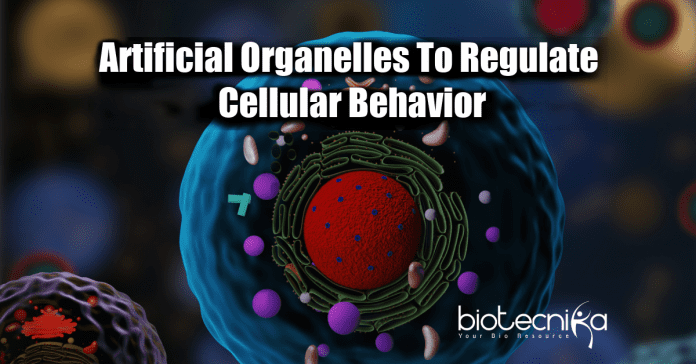Scientists Develop Artificial Organelles To Regulate Cellular Behavior
A method for controlling the phase separation of an emerging class of proteins to develop artificial membrane-less organelles within human cells was demonstrated by the biomedical scientists at Duke University. The advance, similar to controlling how vinegar forms droplets within the oil, gives opportunities for engineering artificial structures to produce entirely new behaviors within cells or regulate existing cell functions.
Proteins function by folding into specific 3 Dimensional shapes that communicate with various biomolecular structures. Scientists previously thought that proteins required these fixed shapes to work. However, a large new class of intrinsically disordered proteins (IDPs) have been discovered in the last 20 years, which do not fold into a defined 3 Dimensional shape – that have large regions that are “floppy.” Currently, it is understood that these regions play an essential role in controlling various cellular functions, which was formerly unrecognized.
Intrinsically disordered proteins are likewise beneficial for biomedical applications since they can undergo phase transitions – for instance, changing from a liquid to a gel, or from a soluble to an insoluble state, and back again – in action to ecological triggers, like temperature changes. These characteristics likewise determine their phase behavior in cellular environments and are managed by adjusting characteristics of the IDPs, such as the sequence in which the amino acids are linked together or their molecular weight.
Ashutosh Chilkoti, the Alan L Kaganov Distinguished Professor of Biomedical Engineering at Duke University, said, although there are lots of natural IDPs that show phase behavior in cells, they are available in various flavors, as well as it has been challenging to discern the rules that control this behavior. This research gives fundamental engineering concepts to program this behavior within a cell.
Michael Dzuricky, a research scientist, working in the Chilkoti laboratory and first author of the study, said that others in the field had taken a top-down approach where they’ll make a change to a natural IDP and also see how its behavior modifications within a cell. They are taking the contrary approach as well as developing their artificial IDPs from easy thermodynamic concepts. This allows the scientists and others to specifically tune a single property – the shape of the IDPs phase diagram – to comprehend better how biological behavior is influenced by this factor.
The scientists begin by looking to nature for examples of IDPs that come together to form “biomolecular condensates” within cells, in the new research. Developing compartments without even building a membrane to encapsulate it is enabled by these weakly-held-together structures. Utilizing one such IDP from the common fruit fly as a basis, the scientists draw from their comprehensive history of collaborating with IDPs to engineer a molecularly simpler artificial version that maintains the very same behavior.
This simpler version permitted the scientist to make specific modifications to the amino acids of the IDPs and molecular weight of the IDP. The scientists reveal that, based upon how these two variables are tweaked, the IDPs integrated to develop these compartments in a test tube at various temperature levels. The scientists acquired a solid understanding of which design parameters are essential to control the IDP’s behavior by constantly trying numerous tweaks as well as temperatures.
The scientist then studied exactly how their engineered IDPs behave within Escherichia coli, as a test tube is not the same as a living cell. As anticipated, their artificial IDPs organized together to form a tiny droplet within the cytoplasm of the cell. The researchers showed that using their test tube principles as a guide, they could predictably control exactly how they coalesced, as the IDP’s behavior was currently so well comprehended.
Dzuricky claimed that they were able to alter temperatures in cells to develop a total description of their phase behavior, which were similar to their predictions in the test-tube study, and they also could make different artificial IDP systems where the droplets that are formed have different material properties.
In other words, they could program the IDPs to form droplets or compartments of varying densities within cells, since the scientists understood how to adjust the dimension and composition of the IDPs to respond to temperature. The researchers then utilized their newfound expertise, as nature commonly does, to produce an organelle that does a particular function within a cell, to demonstrate how this ability could be useful to biomedical designers.
The scientist revealed that they might use the IDPs to envelop an enzyme to regulate its activity level. The IDPs hold on the enzyme either increased or lowered by varying the molecular weight of the IDPs, which subsequently influenced how much it could interact with the rest of the cell.
The scientists selected an enzyme used by Escherichia coli to convert lactose into usable sugars, to demonstrate this ability. But, in this situation, to determine how the engineered IDP organelle was influencing enzyme activity, the scientists tracked this enzyme’s activity with a fluorescent reporter in real-time.
The scientist thinks they might utilize their new IDP organelles in the future, to manage the activity levels of biomolecules vital to disease states. Or to understand how and why IDPs sometimes malfunction and learn exactly how natural IDPs fill similar cellular functions.
Dzuricky said that this is the first time anyone has had the ability to precisely specify how phase separation actions inside cells are controlled by the protein sequence. They utilized an artificial system, but they believe that the very same rules apply to natural IDPs and are thrilled to begin evaluating this concept.
Chilkoti said that by integrating them into these artificial IDPs, we could likewise start to program this type of phase behavior with any protein inside the cell. They wish that these artificial IDPs will certainly provide new tools for synthetic biology to manage cell behavior.
The outcomes of the study are published in the journal Nature Chemistry and the study was supported by the National Science Foundation and the National Institutes of Health.
Scientists Develop Artificial Organelles To Regulate Cellular Behavior
Author: Sruthi S























